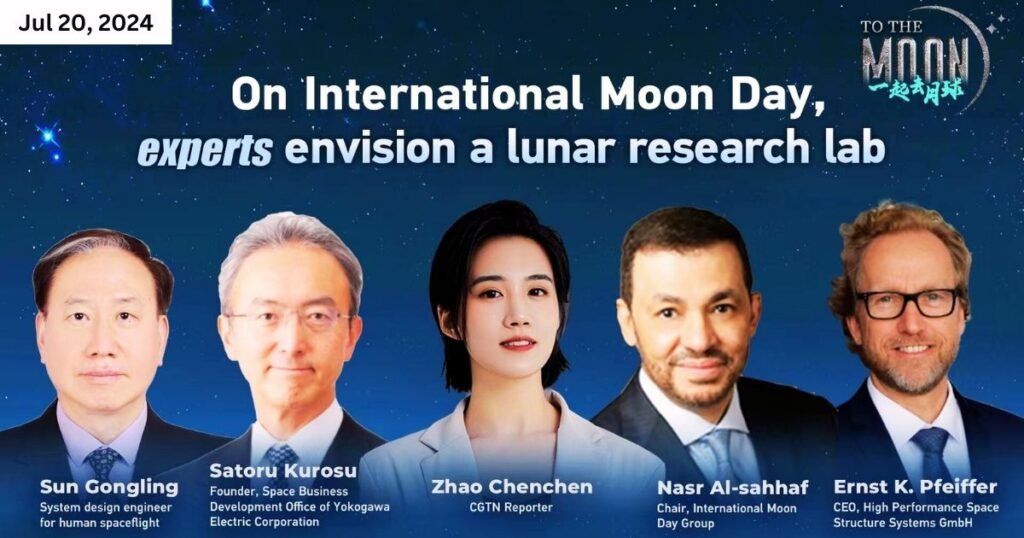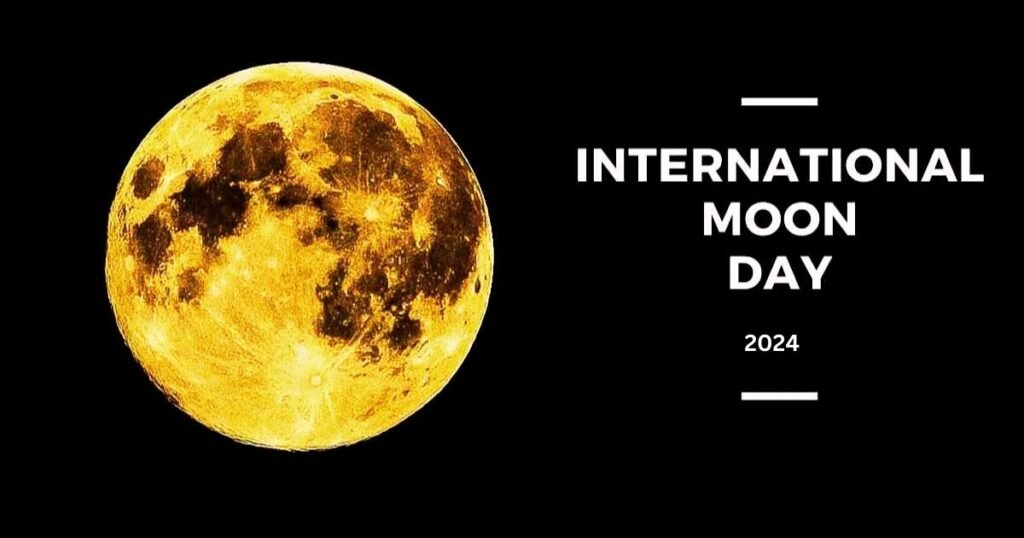Introduction
For millennia, the Moon has captivated humanity. It has been a muse for poets, a celestial guide for travelers, and a source of scientific wonder. On July 20th of each year, we celebrate this awe-inspiring orb with International Moon Day! This UN-designated day commemorates not only the Moon itself, but also the pinnacle of human achievement – the Apollo 11 mission and the first human steps on another world.
This article delves into the history and significance of International Moon Day. We’ll explore the Moon’s fascinating past, its profound impact on Earth, and the exciting future of lunar exploration. We’ll also provide fun and educational ways to celebrate this special day, making it a memorable learning experience for all ages.
Read More: Tomorrowland

A Look Back: The History of International Moon Day
The story of International Moon Day begins in 2021. The United Nations General Assembly, recognizing the Moon’s enduring cultural and scientific significance, designated July 20th as a day for global celebration. This date holds immense historical weight – it marks the anniversary of the Apollo 11 moon landing in 1969. Neil Armstrong’s iconic words, “That’s one small step for man, one giant leap for mankind,” echoed across the world, forever changing our relationship with the Moon.
International Moon Day serves a dual purpose. First, it’s a day to honor the incredible feats of human ingenuity and exploration. The Apollo missions, along with countless other lunar endeavors, represent a testament to international collaboration and scientific progress. Second, it’s an opportunity to inspire future generations and foster a deeper understanding of our place in the universe.
The Moon’s Enduring Influence on Earth
Our lunar companion plays a far more significant role in our lives than simply illuminating the night sky. The Moon’s gravitational pull directly impacts Earth’s tides, creating the rhythmic rise and fall of our oceans. These tides have shaped our coastlines, influenced marine life, and even played a role in the development of early human civilizations.
The Moon also stabilizes Earth’s axis, contributing to our planet’s relatively constant tilt. This, in turn, helps regulate our climate and create the distinct seasons we experience. In essence, the Moon plays a crucial role in maintaining the conditions that have allowed life to flourish on Earth.
Beyond the First Footprint: The Future of Lunar Exploration
International Moon Day serves as a springboard for looking towards the future. Following the Apollo missions, lunar exploration entered a period of relative quiet. However, recent years have witnessed a renewed global interest in our lunar neighbor.
Several countries and private space agencies are actively developing plans for a sustained human presence on the Moon. These missions aim to establish lunar bases that could serve as scientific outposts, resource extraction sites, and stepping stones for further exploration of the solar system. International Moon Day is a timely reminder of the immense potential lunar exploration holds for furthering our understanding of the universe and unlocking new possibilities for humanity.

Celebrating International Moon Day: Fun and Educational Activities
There are countless ways to celebrate International Moon Day and ignite a passion for astronomy and space exploration. Here are a few ideas to get you started:
1. Host a Moon-Gazing Party: Gather friends and family for an evening of stargazing. Locate the Moon and observe its different phases. Use binoculars or a telescope (if available) to get a closer look at the lunar surface features like craters and maria (dark, basaltic plains). Share stories and myths about the Moon from different cultures.
2. Organize a Moon-Themed Craft Activity: Engage children in creative activities like making moon rock models, crafting lunar craters in a sand tray, or designing their own lunar rovers.
3. Visit a Planetarium or Science Museum: Many museums and planetariums offer special programs and exhibits around International Moon Day. These events provide an excellent opportunity to learn about lunar science and exploration through interactive displays and presentations.
4. Explore Online Resources: There’s a wealth of information available online about the Moon. NASA’s website, for example, offers a plethora of resources, including images, videos, and educational materials suitable for all ages.
FAQs
1. Why is the Moon important to Earth?
As discussed earlier, the Moon’s influence extends far beyond its celestial glow. Here’s a breakdown of its key roles:
- Tides: The Moon’s gravity creates a “tug-of-war” effect on Earth’s oceans, causing them to rise and fall in a predictable cycle known as tides. These tides have shaped coastlines, influenced marine ecosystems, and played a role in early human settlements near water bodies.
- Climate Stabilization: The Moon’s gravitational pull helps maintain Earth’s axial tilt. This tilt is responsible for our distinct seasons, ensuring a more balanced and habitable climate for life to thrive.
2. Is the Moon really made of cheese?
This is a popular misconception! TheInternational Moon Day is a rocky body primarily composed of elements like oxygen, silicon, aluminum, and iron. The lunar surface is covered in a layer of dust and debris called regolith, which may have contributed to the cheesy appearance in some early observations.
3. What are the different phases of the Moon?
The International Moon Day appearance in the night sky changes throughout the month due to its position relative to the Earth and the Sun. These distinct shapes are known as lunar phases. The main phases include:
- New Moon: The Moon is positioned between the Earth and the Sun, and its night side faces us, making it invisible.
- Waxing Crescent: The Moon appears as a thin crescent, gradually growing as it orbits around Earth.
- First Quarter: The Moon appears half-illuminated, resembling a quarter of a circle.
- Waxing Gibbous: The Moon becomes more visible, appearing more than half-illuminated but not yet full.
- Full Moon: The Moon is fully illuminated on the side facing Earth, appearing as a bright disc.
- Waning Gibbous: The illuminated area of the Moon begins to decrease.
- Third Quarter: The Moon appears half-illuminated again, but this time with the opposite side lit compared to the First Quarter.
- Waning Crescent: The Moon becomes a thin crescent again, progressively shrinking until the New Moon cycle repeats.
4. How did the Moon form?
The exact origin of the International Moon Day remains a topic of scientific debate. The most widely accepted theory suggests a giant impact scenario. According to this theory, a Mars-sized object collided with Earth billions of years ago. The debris from this collision coalesced and eventually formed the Moon.
5. Are there any resources on the Moon?
The Moon holds a wealth of potential resources that could be valuable for future lunar settlements and space exploration. These resources include:
- Water Ice: Evidence suggests the presence of water ice deposits in permanently shadowed craters near the lunar poles. This ice could be a source of drinking water and can be broken down into hydrogen and oxygen, which are essential for rocket fuel.
- Helium-3: This rare isotope of helium is a potential fuel source for future nuclear fusion reactors. Initial studies suggest small quantities of helium-3 might be trapped in the lunar regolith.
6. What are the challenges of living on the Moon?
Establishing a permanent human presence on the International Moon Day with its own set of challenges. These include:
- Harsh Environment: The Moon has a harsh environment with extreme temperatures ranging from scorching hot in sunlight to frigid cold in shadows. There is also no breathable atmosphere, exposing humans to harmful radiation.
- Limited Resources: Water, food, and other essential resources will need to be carefully managed or sourced from the Moon itself.
- Psychological Stress: Living in a confined space with limited human interaction and constant exposure to a harsh environment can take a toll on mental health.
7. Who will likely be the first people to return to the Moon?
Several countries and private space agencies are actively developing plans for crewed lunar missions. The specific entities involved in the first such mission will depend on the pace of technological advancement and international collaboration. However, some of the key players include:
- NASA (USA): The Artemis program aims to land the first woman and the next man on the Moon by 2025, with plans for establishing a sustainable lunar presence.
- CNSA (China): China’s lunar exploration program has achieved significant milestones, including landing robotic rovers and taking lunar soil samples. Future plans might involve crewed missions.
- European Space Agency (ESA): ESA is collaborating with other space agencies and is likely to play a crucial role in future lunar exploration endeavors.
8. Will there ever be tourism on the Moon?
While the technology for widespread lunar tourism is still under development, the future holds exciting possibilities. Private space companies are exploring the possibility of offering suborbital flights, potentially providing glimpses of the International Moon Day and the Earth from space. However, a full-fledged lunar tourism industry with extended stays on the Moon is likely decades away.

9. How can International Moon Day inspire the next generation of space explorers?
International Moon Day serves as a springboard for igniting a passion for space exploration in young minds. Here are some ways to utilize this day for inspiration:
- Educational Activities: Engage children in activities like building model rockets, learning about the solar system, or participating in citizen science projects related to lunar research.
- Stargazing Events: Organize moon-gazing parties or visit local astronomy clubs to observe the Moon and other celestial objects.
- Books and Documentaries: Introduce children to engaging books and documentaries that explore the wonders of space and the history of lunar exploration.
By fostering curiosity and providing opportunities to learn about the Moon and its potential, International Moon Day can help shape the next generation of space pioneers.
10. What are some ways to stay informed about future lunar exploration missions?
Staying updated on lunar exploration advancements is easier than ever. Here are some resources:
- Space Agency Websites: Major space agencies like NASA, ESA, and CNSA have dedicated sections on their websites outlining their lunar exploration programs and upcoming missions.
- Space News Websites: Several reputable online publications specialize in space news and provide in-depth coverage of lunar exploration activities.
- Social Media: Many space agencies and organizations maintain active social media presences, offering updates and insights on lunar exploration missions.
International Moon Day is a celebration of our celestial neighbor, a testament to human achievement, and a glimpse into the exciting future of space exploration. By actively engaging in the activities and resources mentioned above, you can become a part of this ongoing lunar odyssey!




